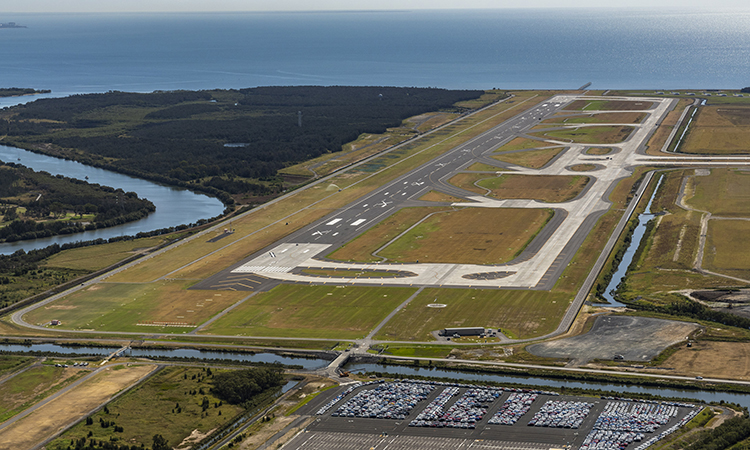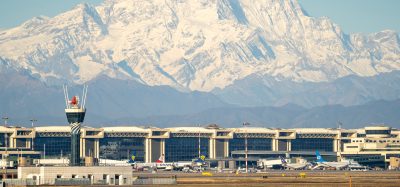Brisbane Airport’s new runway: What it means for the future growth and development of Brisbane
- Like
- Digg
- Del
- Tumblr
- VKontakte
- Buffer
- Love This
- Odnoklassniki
- Meneame
- Blogger
- Amazon
- Yahoo Mail
- Gmail
- AOL
- Newsvine
- HackerNews
- Evernote
- MySpace
- Mail.ru
- Viadeo
- Line
- Comments
- Yummly
- SMS
- Viber
- Telegram
- Subscribe
- Skype
- Facebook Messenger
- Kakao
- LiveJournal
- Yammer
- Edgar
- Fintel
- Mix
- Instapaper
- Copy Link
Posted: 31 March 2021 | Paul Coughlan | 3 comments
Brisbane Airport’s new runway was five decades in the making and under construction for eight years. Paul Coughlan, Head of Infrastructure Development at Brisbane Airport Corporation, speaks to International Airport Review about why it represents a runway into the future.
https://www.youtube.com/watch?v=VQvhBNWPnLQ in urlShaping the future places in which we work, live and play is no easy task. It is the challenge that planners, civil engineers and those involved in wider infrastructure project teams tackle head-on regularly, and we would not have it any other way.
For Brisbane and for Australia, you would be hard pressed to find a better example of a city-shaping planning success than Brisbane’s new runway (BNR)”
It demands foresight and vision – an understanding beyond simply ‘what was’ and ‘what is’ to allow for what might possibly be. It is planning for a future of growth and potential, rich and abundant beyond our own lifetime.
You will have to forgive my bias, but for Brisbane and for Australia, you would be hard pressed to find a better example of a city-shaping planning success than Brisbane’s new runway (BNR). After all, the new runway was the result of incredible foresight from all three levels of government and a project that was nearly half a century in the planning.
The level of passion and pride I have for this piece of infrastructure has not waned. If anything, it continues to strengthen, particularly during the uncertainty and upheaval of the COVID-19 pandemic. It was always designed to be a runway for the future.
A brief history of BNR’s not so brief history
In February 1971, a joint committee comprising of members of the federal government (Australia), state government (Queensland) and local government (Brisbane City) recommended the construction of a new airport for Brisbane, 5km north of the then-existing site at Eagle Farm, to bring Brisbane up to international standards and to cater for forecasted population growth.
In 2005, BAC commenced the planning and approval process for the BNR and, fast-forward to 12 July 2020, the visionary plan for a world-class airport featuring a widely spaced parallel runway system in Australia’s third-largest capital city finally came to fruition”
Later that year, a wide-spaced parallel runway system in a north-south alignment became part of Brisbane Airport’s (BNE) long-term planning. The parallel system remained the central planning feature for future expansion in the period up to Brisbane Airport Corporation’s (BAC) purchase of Brisbane Airport in 1997. BAC retained this planning vision, with some minor improvements and tweaks, in its first two Master Plans in 1998 and 2003, respectively.
In 2005, BAC commenced the planning and approval process for the BNR and, fast-forward to 12 July 2020, the visionary plan for a world-class airport featuring a widely spaced parallel runway system in Australia’s third-largest capital city finally came to fruition with BNR’s official opening.
The final design is a nod to the legacy of the early planners in selecting a site and airfield layout that remained the best solution half a century on. While the vast majority of its true potential and benefits will be seen in the decades to come, Brisbane is already starting to reap the rewards.
Changing the status quo
Prior to the COVID-19 pandemic, and as far back as 2012, an unprecedented increase in passenger numbers and flights started to place enormous pressure on Brisbane Airport’s runway system, which effectively was operating on only a single main runway more than 90 per cent of the time due to restrictions on the use of a smaller cross runway.
As an ‘end of the line’ airport, we had no capacity during our peak periods, severely limiting our ability to meet the growing demand and causing the build-up of delays for passengers and airlines. We also had no system redundancy to ‘catch-up’ on delays from the morning peaks or severe weather conditions, which caused a knock-on effect to on-time performance across the national network, angering passengers who expected and deserved reliable services, as well as having a financial cost to airlines and the airport. These issues would have amplified significantly had the new runway not been built.
Enabling growth and liveability
Airports are synonymous with excitement, anticipation, progress, connection and new beginnings. Airports are also vital to a city’s success and growth.
With the addition of a parallel runway, the future growth and development potential for Brisbane Airport and the greater Brisbane region is exponential”
There is no doubt that Brisbane Airport is the enabler of social, cultural and economic liveability of the city of Brisbane and the state of Queensland. With the addition of a parallel runway, the future growth and development potential for Brisbane Airport and the greater Brisbane region is exponential.
Brisbane’s new runway is forecast to generate an estimated 7,800 new jobs by 2035 and an additional AUD $5 billion in annual economic benefit to the region.
It will also put Brisbane in the best position possible to attract international major events to our great state, with the 2014 G20 Summit and the Gold Coast 2018 Commonwealth Games successfully delivered during a time where Brisbane Airport was at capacity.
Our state is huge – 1,727,000km2 in size, making it nearly five times the size of Japan and seven times the size of Great Britain. So, when you consider that just under half of Queensland’s five-million-plus population lives in the greater Brisbane area, job creation, event attraction and economic growth is imperative.


Credit: Brisbane Airport Corporation
Infrastructure sparking infrastructure
Brisbane’s new runway is so much more than 3.3km of asphalt and crushed rock.
It has future-proofed operations at Brisbane Airport and is a key enabler for tourism, investment and trade opportunities for the city and state, supporting more than $15 billion of major projects”
It has future-proofed operations at Brisbane Airport and is a key enabler for tourism, investment and trade opportunities for the city and state, supporting more than $15 billion of major projects being developed in South East Queensland over the next decade, including Queen’s Wharf.
BNR has given investors like The Star Entertainment Group confidence to pour billions of dollars into a new entertainment and lifestyle precinct, Queen’s Wharf, in Brisbane’s central business district (CBD).
Geoff Hogg, The Star Entertainment Group’s Managing Director – Queensland, has been quoted as saying that the new runway was not just a gateway to Brisbane, but a gateway for tourism to Queensland: “Any growth in the international flights and direct flights coming into Brisbane benefits the whole of the state from a tourism perspective. For us, investing with Queen’s Wharf in Brisbane, knowing that the expansion of the airport is coming on board, the extra airlines that they are getting, the infrastructure with the cruise ship terminal; both of those really create Brisbane as a gateway city.”
Within our own precinct, we have been able to attract and secure a number of world-class businesses due to the operational efficiencies and connectivity enabled by the new runway, with exciting projects like the AUD $300 million BNE Auto Mall still to come.
Recovery is inevitable
Travel is at the heart of modern society, and the human need to meet other people, to connect and to explore means that, ultimately, nothing will keep us grounded forever”
It might sound strange to say – bearing in mind that COVID-19 has brought the world’s airports and airlines almost to a halt – but I do see hope. Travel is at the heart of modern society, and the human need to meet other people, to connect and to explore means that, ultimately, nothing will keep us grounded forever.
The aviation industry is resilient and has weathered many storms. Air travel will bounce back, as it did after the 11 September 2001 terror attacks and the global financial crisis. It has always rebounded, and it rebounds strongly.
Now more than ever, it is crucial that we have the infrastructure and mechanisms in place to allow our great city and state to recover from COVID-19. Brisbane Airport, and this new runway, will play a strong part in that.
Even though the skies are quieter than they have been for decades, I believe that the timing of Brisbane’s new runway opening was fortuitous.
Had we not started site preparation in 2012, this project may still be on the drawing board, and the economics of building it in the next decade would probably have made it impossible.
Instead of heading into the mid-21st century with the best aviation growth capacity in Australia, Queensland would have been looking at the future constrained and hamstrung, and we would not be in this ideal position to make the speediest of economic recoveries from COVID-19.
The new runway has given Brisbane Airport the greatest aviation capacity of any capital city airport in Australia, allowing for up to 110 aircraft movements per hour, which is comparable to major international hubs like Singapore Changi Airport (SIN) and Hong Kong International Airport (HKG)”
The new runway has given Brisbane Airport the greatest aviation capacity of any capital city airport in Australia, allowing for up to 110 aircraft movements per hour, which is comparable to major international hubs like Singapore Changi Airport (SIN) and Hong Kong International Airport (HKG).
Prior to COVID-19, this untapped capacity was crucial in securing new airlines and routes, including Qantas services to San Francisco International Airport (SFO). As we emerge from the pandemic, Brisbane Airport will be in the best position possible to attract new airlines and new routes, connecting Brisbane to the world more than ever before.
Throughout the pandemic, our aviation capacity has ultimately protected and enabled Australia’s domestic market in a climate where international travel has all but ceased.
Brisbane Airport remains the busiest airport in the country, ahead of our southern counterparts in Sydney and Melbourne, connecting more Australians to interstate and intrastate destinations. Without this, the situation for an airport in a continent locked entirely by sea would be dire.
The future is bright
The last 12 months have been difficult for everyone in the aviation and travel industries, as well as the whole community, but we have never lost sight of the fact that this project has been built for the long-term. It will serve us well for many decades to come.
At Brisbane Airport, we are creating the future. Very soon, once again, we will be connecting the world. We are generating the jobs of tomorrow. We are reuniting people. We are creating new opportunities. We are fuelling the economy. Best of all, we are providing hope and inspiration.
This runway is a beacon of hope for a very bright future. Not only our immediate future, but also the future of generations to come.
Paul Coughlan holds a Bachelor of Civil Engineering and is the Head of Infrastructure Development at Brisbane Airport Corporation (BAC). He has worked for BAC since November 2002 in a number of roles.
Coughlan commenced the Project Director role for Brisbane’s new runway (BNR) in mid-2007. He was responsible for overseeing the planning and delivery of the construction programme, including consultant and contractor procurement, delivery, cost management, environment, stakeholder management and safety.
Related topics
Aircraft, Airport construction and design, Airside operations, Capacity, COVID-19, Passenger experience and seamless travel, Passenger volumes, Runways and pavements


















i will always go for offsite parking option ,
It’s probably worth mentioning that those international hubs Brisbane Airport is willing to be on par with are not pushing 100s of low flying planes over residential areas everyday. HK airport is built on an artificial island far far away from populated areas and Singapore airport’s runways are not angled towards local people’s homes.
We need bigger airport in Brisbane with lots of shopping options for better economy. Have a look Singapore and Dubai airports. Brisbane airport looks like a third world country airport.